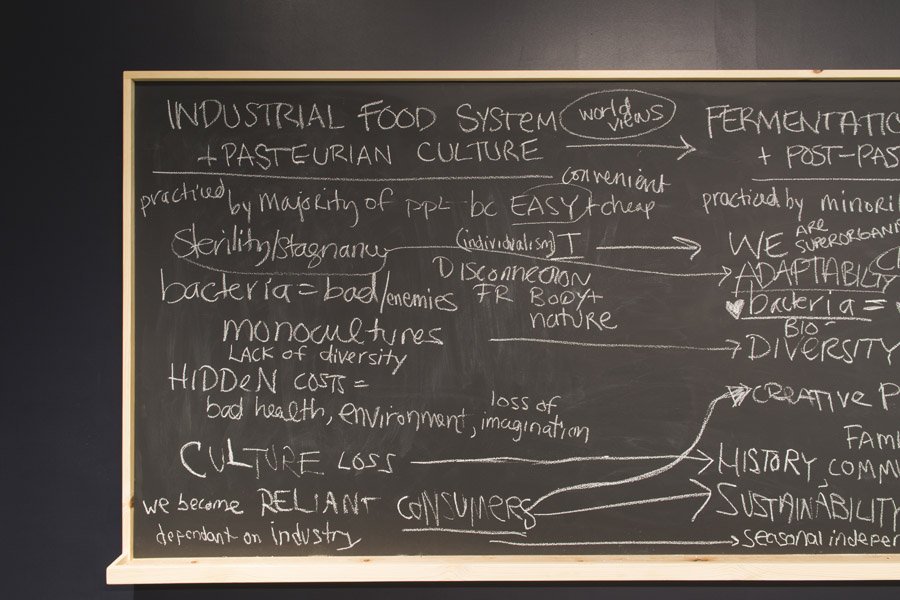EdibleEcologies: OS Fermentation “Microbial Selfies” (2015). Source: EcoArtTech
OS Fermentation
A Human and Microbial Collaboration
OS Fermentation is a social sculpture that works to bring together human, bacterial, and ecological into collaborative and experimental union by experimenting with the ancient food practice of fermentation. The workshop is part of a bio-art series entitled EdibleEcologies under her art/theory collaborative with Cary (Adams) Peppermint, that work to revive endangered food practices through the memory, experimentation, and collaboration in order to “save them from extinction and remix them for the future.” These events are highly collaborative engagements with the public that allow for hands-on experimentation with biological, cultural, and digital scenarios. The incentive of these performances is to promote recovery from a cultural memory disorder EcoArtTech calls “industrial amnesia,” which concerns the impact of industrialization and modernization on the human psyche and the erosion of endangered food and environmental practices.
OS Fermentation Workshop, Bemis Center 2015. Source: EcoArtTech
The workshop took place in three stages. The first was an introduction to the idea concerning the modern industrial food system, microbiology, public health, and the “modernist declaration of war on bacteria” through a reading of Michael Pollan’s book Cooked. The discussion was an opportunity to think about the medium of fermentation as a viable and safe method for food preservation that has been passed down through ancestry. This method runs counter to industry standards for food preservation such as refrigeration, irradiation, and pasteurization. During the discussion, Nadir and Peppermint served their “signature live-culture, homemade, non-industrial, non-standardized, non-conventional acclaimed fermented beverages” such as Coffee Banana Hard Cider, Strawberry Matcha Wine, and Blueberry Chocolate Kombucha.
Second, participants workshopped making fermented veggie krauts, hard cider, and honey-wine. Nadir asked participants to handle, cut, massage, and package the food into mason jars: creating a symbiotic relationship that would cultivate an environment for bacteria to grow. Nadir cites the experience as “wild, unpredictable and playful – a collaboration between species that work toward creating living yet durable food that provides a regular source of diverse intestinal flora.” In this sense, bio-art becomes a performance for political discourse, in which the processes of natural science is woven into cultivating or even demanding a culture of food alternatives in lieu of conventional preservation methods. The participants took home the jars of fermented vegetables they made in order to watch the fermentation process as an “unfolding, unfinished, interactive artwork, part of a future meal that will boost digestion and immunity, and a viral performance of food independence in a time when diet, nutrition, and humanity’s relationships with edible substances have been industrialized.”
Finally, participants took part in an informal and communal tasting party. Nadir and Peppermint created the dining experience within a “gallery installation” of microbial growth (fermenting process): digital prints of “microbial selfies” created during the series by “custom electronics and software that allow microbes to take their own selfies and add image manipulation effects to their images based on the shifting pH levels, oxygen, and color values of the fermentation process” (ibid).

Nadir and partner Corey Peppermint talk with participants about human and microbial collaboration. Source: EcoArtTech

Shredding Vegetables

"Eat Together" OS Fermentation

Nadir eating with participants

Gallery of Fermenting Process

Microbial Selfies
Overall, the artists’ intention to remedy “industrial amnesia” through projects such as OS Fermentation is not rooted in building solutions toward the “global environmental health crisis.” Nadir and Peppermint argue that the majority of scholars, scientists, and even activists continue to rely on nostalgic tendencies to “fix” or “restore” such worldwide dilemmas by drawing from empirical and objective facts and figures to incentive solutions. “Industrial amnesia” is the crisis of memory and the imagination, which the artists believe is at the root of the contemporary food crisis. Thus OS Fermentation works to revive consciousness through an alternative symbiosis that ignites new body ecology, moving from “passive consumer” to active empowerment of the material body. In this sense, OS Fermentation reveals the possibilities of critical and political consciousness at work, as intellectual and everyday habits are continually refigured through collaborative and experimental artistic engagements.
Moreover, OS Fermentation represents a feminist response to bio-art as a masculine project as “a performative exploration of modernization, its regimes of purity, cleanliness, and sterilization, and its creation of a hyper-hygienic social order.” Nadir states that bio-art is a currently a “huge art form” that remains tied conventional spaces such as working in labs, methods such as the use of beakers, and modes of thinking such as hygiene and cleanliness. Fermentation works in opposition to these processes, as the very activities that fermentation embodies are that which an individual thrives within: “unpredictability, experimentation, collaboration, spontaneity, interactivity, and wildness.”


